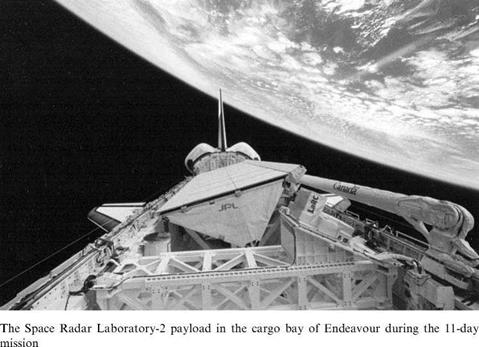STS-68
|
Int. Designation |
1994-062A |
|
Launched |
30 September 1994 |
|
Launch Site |
Pad 39A, Kennedy Space Center, Florida |
|
Landed |
11 October 1994 |
|
Landing Site |
Runway 22, Edwards AFB, California |
|
Launch Vehicle |
OV-105 Endeavour/ET-65/SRB BI-067; SSME #1 2028; #2 2033; #3 2026 |
|
Duration |
11 days 5 hrs 46 min 8 sec |
|
Call sign |
Endeavour |
|
Objective |
Operation of the Space Radar Laboratory (SRL)-2 in the payload bay |
Flight Crew
BAKER, Michael Allen, 40, USN, commander, 3rd mission Previous missions: STS-43 (1991); STS-52 (1992)
WILCUTT, Terrence Wade, 44, USMC, pilot SMITH, Steven Lee, 35, civilian, mission specialist 1 BURSCH, Daniel Wheeler, 37, USN, mission specialist 2, 2nd mission Previous mission: STS-51 (1993)
WISOFF, Peter Jeffrey Karl, 36, civilian, mission specialist 3, 2nd mission Previous mission: STS-57 (1993)
JONES, Thomas David, 39, civilian, mission specialist 4, payload commander, 2nd mission
Previous mission: STS-59 (1994)
Flight Log
After the success of SRL-1, it was hoped that the second mission in the series would be equally rewarding. In order to ensure a smooth (and shorter) flow between the missions, it was decided to place the payload in the same orbiter (Endeavour) and to assign MS Tom Jones from the STS-59 crew as payload commander for STS-68. Endeavour returned from Edwards on 2 May and the SRL payload was removed from the vehicle in the Orbiter Processing Facility on 8 May for inspection, cleaning and maintenance. It was returned to the payload bay on 21 June and by 27 July, Endeavour was back on the pad, ready to support a planned 18 August launch. That attempt was scrubbed at T — 1.9 seconds, when the orbiter’s computers shut down the three SSMEs after they had detected unacceptably high discharge temperatures in the high-pressure oxidiser turbine for SSME #3. This required a return to the VAB to replace all three engines. The launch was rescheduled for 30 September.
|
|
Following the format of SRL-1, the crew of STS-68, working a single-shift system, soon settled down to operate their main payload and host of other mid-deck and secondary experiments once on orbit. The same 400 sites and 19 “super-sites” were targeted as on SRL-1 to provide comparison data during a different season. Unfortunately, there would be no SRL-3 mission to provide a third set of data from a different time of the year (December or January). In addition to the programme’s scheduled activities, the crew took the opportunity to record other images and impressions of Earth’s weather and environmental conditions, including the eruption of the Kliuchevskoi volcano in Kamchatka. They also studied fires in British Columbia, Canada (which had been set for forest management purposes) and used the MAPS equipment to take readings to better understand the carbon monoxide emissions from burning fires.
As well as flying over the same places as on the STS-59 mission (at one point flying the Endeavour just nine metres from where it had flown the previous April), by making small changes to their orbit, the STS-68 crew could take images of areas they had flown over just 24 or 48 hours previously. These interferometric passes were made over central North America, the Amazonian rain forests of Brazil in South America, and the volcanoes in the Kamchatka peninsula in Russia. Images like these taken over long periods of time could provide important data on the movements of the Earth’s surface – of even a few centimetres – that could be invaluable in detecting the preemptive changes in volcanoes or movements in major fault lines prior to earthquakes.
One of the radar observations was of a man-made phenomenon, a deliberate and controlled spillage of oil in the North Sea. This was designed to see if the radar could determine the difference between oil spills and naturally produced fish and plankton oils. Four hundred litres of diesel oil and 100 litres of algae-produced natural oil were dumped into the water for comparison. After the data was collected, it took just two hours for the stand-by recovery vessels to clean up the spillages.
After a one-day extension to the mission, STS-68 was diverted to Edwards from KSC because of bad weather in the vicinity of the Cape. Post-flight evaluation of the mission revealed that there had been 923 attempted data sweeps, of which 910 were successful (98.59%). Of the 292 “super-site” data-gathering attempts, the crew achieved 289 takes (98.97%) and from the 724 X-SAR attempts, 719 were acquired (99.31%). The volume of data collected equated to approximately 25,000 encyclopaedic volumes worth. STS-68 had gathered data from 83 million km2, or about nine per cent of the total Earth surface. Though SRL-3 was not flown, the data from the first two missions would help in planning the SRTM mission flown in 2000.
Milestones
173rd manned space flight
95th US manned space flight
65th Shuttle mission
7th flight of Endeavour
2nd flight of SRL payload combination











